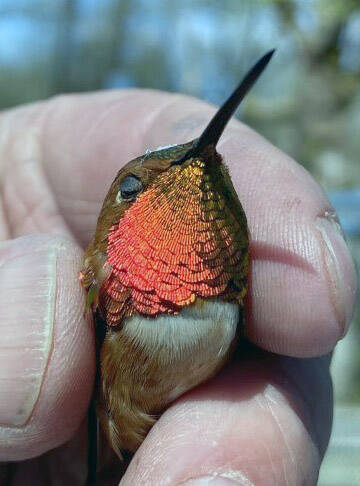This past weekend I participated in the Summer Hummingbird Days event hosted by the Alaska Wildlife Conservation Center. It was a great event focusing on hummingbirds.
We had banding demonstrations as part of an ongoing research project looking at rufous hummingbirds in the northern extent of their current breeding range. Kate McLaughlin, with the Alaska Hummingbird Project, and I were able to share our knowledge through demonstrations and afternoon talks that hundreds of people enjoyed along with the kids activity tables.
For me, one of the most novel parts of the entire weekend was bridging the gap between hummingbirds as cool little individual creatures and their role as pollinators. One of the talks given by Sabrina Farmer of the U.S. Fish and Wildlife Service highlighted the value of native pollinators and the role that rufous hummingbirds play.
Rufous can visit up to 5,000 flowers per day, but until I actually saw hummingbirds with pollen on their beaks, the enormousness of that number never sank in. Then, while giving my talk on climate change and hummingbirds, the slow-to-respond lightbulb finally clicked on.
I am a rather classically trained biologist/naturalist. We seek out diverse, unique or intact habitats and ecosystems that support diverse species. We then do everything in our power to conserve them for future generations.
Unfortunately, in a rapidly changing climate, the stability of these special places is uncertain. Spending our efforts conserving a past condition could waste time, money and energy on something that was ultimately doomed. At the same time, we could fail to support a new species assemblage that needed an assist to persist.
As the crowd began asking me questions on how we could assist rufous going forward, I realized that the key to them expanding into the western Kenai Peninsula is probably not climactic in the sense of temperature, precipitation or humidity. They have wings and will travel.
The problem exists when hummingbirds need to move because their historic areas are deteriorating. The flower resources needed in the new breeding area can’t get there on their own in a timely manner. This leaves the hummingbirds with a new area but a lack of vital resources.
We certainly have all the bugs they need. They are generalist hunters of any soft-bodied, winged insects typically produced in riparian zones, and we have no shortage of those. We have almost everything.
However, what is different between the places they choose now and the rest of the Kenai Peninsula seems to be early flowering resources. We don’t have significant numbers of salmonberry and oval leaf blueberry on the Kenai National Wildlife Refuge like you find in Portage, Hope, Seward and Seldovia. Plants cannot easily move like birds, and this may be where we need to assist.
Along with this wonderful bounty of new breeding lands we might create, they still need good wintering habitat and a way to support the energetic demands to move from breeding to wintering grounds and back. This is where the pollinator gardens might come in.
You may live in urban areas and think that the “Concrete Jungle” with a few green strips of trees is all we can do. But what if a bunch of homeowners converted a 20-foot plot of lawn or pavement into a small native pollinator garden? This network of gardens may be all they need to hopscotch from Mexico to the Kenai Peninsula and allow them to persist in the face of climate change.
A major side benefit we may not realize is that by using native plants in our garden, we are also saving specialized insects like bees, flies, butterflies and moths that we didn’t even know we were losing.
As I stated, there is still much uncertainty about the actual direction the climate will take us. However, with more information collected each year, the models continue to point in a similar direction.
A recent publication in Ornithological Applications looked at the modeled change in bird assemblages across the National Wildlife Refuge System of 525 refuges across the country (https://doi.org/10.1093/ornithapp/duac016).
While many of the predictions are disturbing, one of the most striking numbers I found in the entire report was that there are currently 32 refuges that support breeding rufous hummingbirds. With a 2 degrees Celsius change in temperature through 2050, the number of refuges supporting breeding rufous is predicted to shrink to two!
On the wintering side of things, it is more optimistic; the number of refuges supporting wintering populations of rufous is predicted to rise from 19 to 24. This increase further reinforces the concept that Mexico’s existing preferred winter habitat may ultimately fail them, forcing their winter range northward into the southern United States.
While I am not advocating that we start moving salmonberry and oval leaf blueberry plants on the Kenai refuge right now, it is worth discussing the costs, benefits and limitations today so we are positioned for an effective response if needed in the future.
It could also be something to consider as you are looking for ways to make your own little plot of land more bird-friendly. Supporting native pollinators through your yard plantings may brighten your spirits while contributing to species conservation at a continental scale.
Todd Eskelin is a Wildlife Biologist at Kenai National Wildlife Refuge. Find more Refuge Notebook articles (1999-present) at https://www.fws.gov/Refuge/Kenai/community/Refuge_notebook.html or other info at http://www.facebook.com/kenainationalwildliferefuge.

